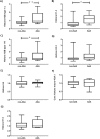Preliminary analysis of proteome alterations in non-aneurysmal, internal mammary artery tissue from patients with abdominal aortic aneurysms
- PMID: 29470511
- PMCID: PMC5823374
- DOI: 10.1371/journal.pone.0192957
Preliminary analysis of proteome alterations in non-aneurysmal, internal mammary artery tissue from patients with abdominal aortic aneurysms
Abstract
Objective: The pathogenesis of abdominal aortic aneurysms (AAA) involves a disturbed balance of breakdown and buildup of arterial proteins. We envision that individuals with AAA carry generalized arterial protein alterations either because of effects of genetically or environmental AAA risk factors or because of compensatory changes due to signaling molecules released from the affected aneurysmal tissue.
Approach: Protein extraction and quantitative proteome analysis by LC-MS/MS (liquid chromatography-mass spectrometry) was done on individual samples from the internal mammary artery from 11 individuals with AAA and 33 sex- and age-matched controls without AAA. Samples were selected from a biobank of leftover internal mammary arterial tissue gathered at coronary by-pass operations.
Results: We identified and quantitated 877 proteins, of which 44 were differentially expressed between the two groups (nominal p-values without correction for multiple testing). Some proteins related to the extracellular matrix displayed altered concentrations in the AAA group, particularly among elastin-related molecules [elastin, microfibrillar-associated protein 4 (MFAP4), lysyl oxidase]. In addition, several histones e.g. (e.g. HIST1H1E, HIST1H2BB) and other vascular cell proteins (e.g. versican, type VI collagen) were altered.
Conclusions: Our results support the notion that generalized alterations occur in the arterial tree in patients with AAA. Elastin-related proteins and histones seem to be part of such changes, however these preliminary results require replication in an independent set of specimens and validation by functional studies.
Conflict of interest statement
Figures


References
-
- Cornuz J, Sidoti Pinto C, Tevaearai H, Egger M. Risk factors for asymptomatic abdominal aortic aneurysm: systematic review and meta-analysis of population-based screening studies. Eur J Public Health. 2004;14(4):343–9. doi: 10.1093/eurpub/14.4.343 . - DOI - PubMed
-
- Wahlgren CM, Larsson E, Magnusson PK, Hultgren R, Swedenborg J. Genetic and environmental contributions to abdominal aortic aneurysm development in a twin population. J Vasc Surg. 2010;51(1):3–7; discussion doi: 10.1016/j.jvs.2009.08.036 . - DOI - PubMed
-
- Lindholt JS, Vammen S, Juul S, Henneberg EW, Fasting H. The validity of ultrasonographic scanning as screening method for abdominal aortic aneurysm. Eur J Vasc Endovasc Surg. 1999;17(6):472–5. doi: 10.1053/ejvs.1999.0835 . - DOI - PubMed
-
- Daly KJ, Torella F, Ashleigh R, McCollum CN. Screening, diagnosis and advances in aortic aneurysm surgery. Gerontology. 2004;50(6):349–59. doi: 10.1159/000080172 . - DOI - PubMed
-
- Kuivaniemi H, Ryer EJ, Elmore JR, Tromp G. Understanding the pathogenesis of abdominal aortic aneurysms. Expert Rev Cardiovasc Ther. 2015;13(9):975–87. Epub 2015/08/27. doi: 10.1586/14779072.2015.1074861 ; PubMed Central PMCID: PMCPMC4829576. - DOI - PMC - PubMed
Publication types
MeSH terms
Substances
LinkOut - more resources
Full Text Sources
Other Literature Sources
Miscellaneous

